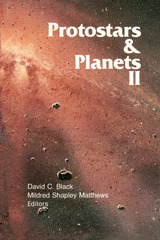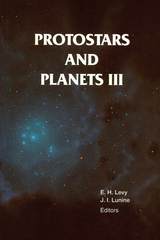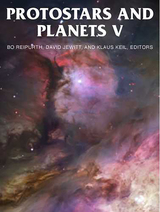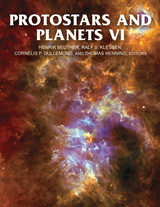6 books about Protostars

Protostars and Planets
Tom Gehrels
University of Arizona Press, 1979
Originally published in 1979, at the time of it's publication this work was a unique source book on star formation and the origin of planetary systems from some 35 distinguished authors. Topics include the formation of stars from the cloudy to the stellar to the planetary state. Special emphasis on stars believed capable of producing planets. This foundational work sought to define a new discipline and set the course for the University of Arizona Space Science series.
[more]

Protostars and Planets II
David C. Black
University of Arizona Press, 1985
Based on meetings held in Tucson, Arizona in 1984, this volume brought up-to-date recent advances and research on the cosmogony of stars and planets. This book presents the written thoughts of the principle speakers (and their colleagues) from the 1984 meeting. This work continued work started in 1978 to investigate the problems of star formation and the formation of the solar system.
[more]

Protostars and Planets III
Eugene Levy
University of Arizona Press, 1993
Previous Space Science Series volumes Protostars and Planets (1978) and Protostars and Planets II (1985) were among the most timely offerings of this illustrious collection of technical works. Protostars and Planets III continues to address fundamental questions concerning the formation of stars and planetary systems in general and of our solar system in particular. Drawing from advances in observational, experimental, and theoretical research, it summarizes our understanding of these processes and addresses major open questions and research issues. Among the more notable subjects covered in the more than three dozen chapters are the collapse of clouds and the formation and evolution of stars and disks; nucleosynthesis and star formation; the occurrence and properties of disks around young stars; T Tauri stars and their accretion disks; gaseous accretion and the formation of the giant planets; comets and the origin of the Solar-System; and the long-term dynamical evolution and stability of the solar system.
Protostars and Planets III reflects the enormous progress made in understanding star and planet formation as a result of new observational capabilities and cooperative research among scientists from diverse fields.
Protostars and Planets III reflects the enormous progress made in understanding star and planet formation as a result of new observational capabilities and cooperative research among scientists from diverse fields.
[more]

Protostars and Planets IV
Vince Mannings
University of Arizona Press, 2000
Atextbook and a status report for every facet of research into the formation of stars and planets, Protostars and Planets IV brings together 167 authors who report on the most significant advances in the field since the publication of the previous volume in 1993. Protostars and Planets IV reflects improvements in observational techniques and the availability of new facilities such as the Infrared Space Observatory, the refurbished Hubble Space Telescope, and the 10-m Keck telescopes. Advances in computer technology and modeling methods have benefited theoretical studies of molecular clouds, star formation, and jets and disks, while recent analyses of meteorites yield important insights into conditions and processes within our Sun's early protoplanetary disk. The 49 chapters describe context and progress for observational and theoretical studies of the structure, chemistry, and dynamics of molecular clouds; the collapse of cores and the formation of protostars; the formation and properties of young binary stars; the properties of winds, jets, and molecular outflows from young stellar objects; the evolution of circumstellar envelopes and disks; grain growth in disks and the formation of planets; and the properties of the early Solar nebula.
Protostars and Planets IV is also the first book to include chapters describing the discoveries of extrasolar planets, brown dwarfs, and Edgeworth-Kuiper Belt objects, and the first to include high-resolution optical and near-infrared images of protoplanetary disks. Protostars and Planets IV is an unsurpassed reference not only for established researchers but also for younger scientists whose imagination and work will lead to tomorrow's discoveries.
Protostars and Planets IV is also the first book to include chapters describing the discoveries of extrasolar planets, brown dwarfs, and Edgeworth-Kuiper Belt objects, and the first to include high-resolution optical and near-infrared images of protoplanetary disks. Protostars and Planets IV is an unsurpassed reference not only for established researchers but also for younger scientists whose imagination and work will lead to tomorrow's discoveries.
[more]

Protostars and Planets V
Edited by Bo Reipurth, David Jewitt, and Klaus Keil
University of Arizona Press, 2007
Increasing discoveries of new planets beyond our solar system are invigorating the quest for new knowledge and understanding of the birth of stars and planets. This new volume in the Space Science Series, with 249 contributing authors, builds on the latest results from recent advances in ground and space-based astronomy and in numerical computing techniques to offer the most detailed and up-to-date picture of star and planet formation, including the formation of our own solar system. This book emphasizes the cross-disciplinary aspects of the field, with a particular focus on the early evolution of our solar system. Protostars and Planets V is the new foundation for further advancement in the fields of stellar and planetary formation, making it an indispensable resource for researchers and students in astronomy, planetary science, and the study of meteorites.
[more]

Protostars and Planets VI
Edited by Henrik Beuther, Ralf S. Klessen, Cornelis P. Dullemond, and Thomas Henning
University of Arizona Press, 2014
The revolutionary discovery of thousands of confirmed and candidate planets beyond the solar system brings forth the most fundamental
question: How do planets and their host stars form and evolve? Protostars and Planets VI brings together more than 250 contributing authors at the forefront of their field, conveying the latest results in this research area and establishing a new foundation for advancing our understanding of stellar and planetary formation.
Continuing the tradition of the Protostars and Planets series, this latest volume uniquely integrates the cross-disciplinary aspects of this broad field. Covering an extremely wide range of scales, from the formation of large clouds in our Milky Way galaxy down to small chondrules in our solar system, Protostars and Planets VI takes an encompassing view with the goal of not only highlighting what we know but, most importantly, emphasizing the frontiers of what we do not know.
As a vehicle for propelling forward new discoveries on stars, planets, and their origins, this latest volume in the Space Science Series is an indispensable resource for both current scientists and new students in astronomy, astrophysics, planetary science, and the study of meteorites.
question: How do planets and their host stars form and evolve? Protostars and Planets VI brings together more than 250 contributing authors at the forefront of their field, conveying the latest results in this research area and establishing a new foundation for advancing our understanding of stellar and planetary formation.
Continuing the tradition of the Protostars and Planets series, this latest volume uniquely integrates the cross-disciplinary aspects of this broad field. Covering an extremely wide range of scales, from the formation of large clouds in our Milky Way galaxy down to small chondrules in our solar system, Protostars and Planets VI takes an encompassing view with the goal of not only highlighting what we know but, most importantly, emphasizing the frontiers of what we do not know.
As a vehicle for propelling forward new discoveries on stars, planets, and their origins, this latest volume in the Space Science Series is an indispensable resource for both current scientists and new students in astronomy, astrophysics, planetary science, and the study of meteorites.
[more]
READERS
Browse our collection.
PUBLISHERS
See BiblioVault's publisher services.
STUDENT SERVICES
Files for college accessibility offices.
UChicago Accessibility Resources
home | accessibility | search | about | contact us
BiblioVault ® 2001 - 2024
The University of Chicago Press









